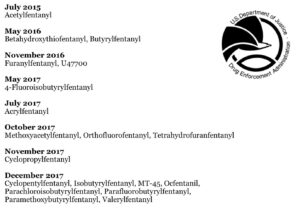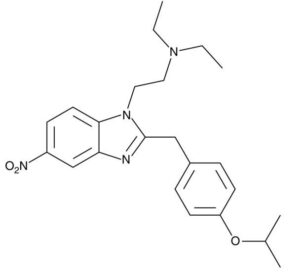By Kevin Shanks, D-ABFT-FT
Over the last several years, the Drug Enforcement Administration (DEA) has moved to ban various newly emerged illicit opioids as Schedule I controlled substances. From 2015-2017, they controlled 19 fentanyl analogs and other opioids. In 2018, the DEA banned any substitutions to the fentanyl core chemical structure and classified them as “fentanyl-related substances”.

Waves of Federal Legislation for Opioids
DEA, 2015 – 2017
After this legislation in 2018, compounds that were chemically dissimilar from fentanyl and analogs began to emerge. The major family of non-fentanyl related compounds to emerge is known as the nitazenes, which are based on a benzimidazole chemical structure. This family of opioids was first synthesized in the 1950s in the pharmaceutical industry as potential analgesic and anesthetic medications. The first compound, also the most potent, is etonitazene. Other compounds in this family include butonitazene, flunitazene, isotonitazene, metonitazene, and N-pyrrolidinoetonitazene. Pharmacologically, these compounds are mu opioid receptor agonists, much like morphine, heroin, and fentanyl. In vitro data suggests that these compounds have analgesic potentcies similar to or greater than fentanyl, and because of this potency and potential for respiratory depression, they have never been investigated further or approved for use in medicine.

Chemical Structure of Isotonitazene.
Kevin G. Shanks (2022)
We screen for nitazene compounds by liquid chromatography with quadrupole time of flight mass spectrometry (LC-QToF-MS) and confirm their identity by liquid chromatography with triple quadrupole mass spectrometry (LC-MS/MS) test. Test specifics can be found in the Axis online catalog.
From June 1, 2021 to May 1, 2022, we detected a total of four nitazene compounds (metonitazene, isotonitazene, flunitazene, and N-pyrrolidinoetonitazene) in 128 postmortem toxicology blood samples across eight states (Florida, Illiniois, Indiana, Michigan, Nebraska, Ohio, Texas, and Wisconsin). Fentanyl was most commonly found alongside nitazene compounds, but other substances included 4-ANPP, acetylfentanyl, naloxone, methamphetamine, THC, cocaine/benzoylecgeonine, and morphine.
If you have any questions about these newly emerged nitazene compounds, please reach out to subject matter experts at Axis by email at [email protected].
References
Axis Forensic Toxicology internal data for nitazene analysis. 06/01/2021 – 05/01/2022.
